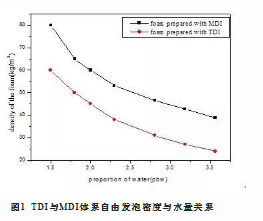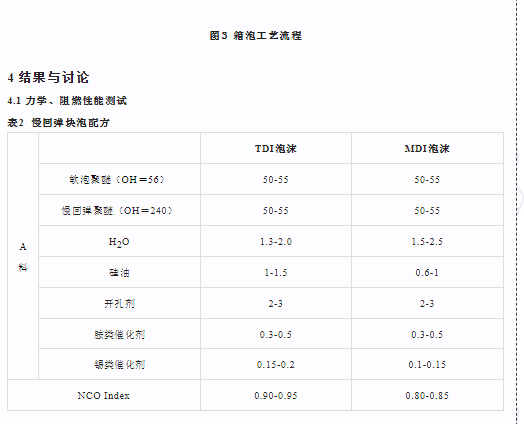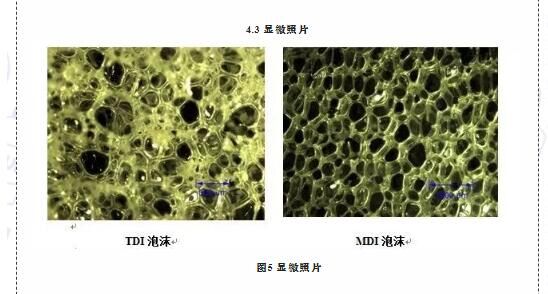1.Foreword
As we all know, polyurethane slow rebound foam is also called memory foam and viscoelastic foam. Its unique feature is that it can conform to the shape of the load, maximizing the contact area, minimizing the stress gradient, and allowing the stress concentration point to be Relief was obtained, with no local squeezing or stinging sensation. Therefore, slow-rebound block foam is widely used as mattresses, cushions, etc., which is beneficial to the blood circulation of the human body and is a high-comfort health care foam.
Theoretically, the resilience of polyurethane foam is related to the degree of phase separation and glass transition temperature. By selecting raw materials to adjust the glass transition temperature of the foam to the use temperature and reducing the degree of phase separation of the foam, slow rebound foam can be obtained. The usual process route is to mix low hydroxyl value soft foam polyether with higher hydroxyl value polyether to increase the cross-linking density of the foam, thus increasing the glass transition temperature of the foam and reducing the degree of phase separation. For example, CN1606580, CN1572186, and CN1229803 are all based on this theory [1-3].
Traditional slow-rebound polyurethane block foam is prepared with TDI. In recent years, due to people’s gradual emphasis on environmental protection, people are paying more and more attention to MDI. Not only in the field of molding, they also hope to try MDI technology in the field of block foam. [4-10]. This article introduces a modified MDI, brand number wannate8107, used to prepare slow rebound foam.
The reason why MDI prepolymerization technology is used is that the free foaming density of MDI-based foam is higher than that of TDI-based foam. In order to maintain the same foaming density, the MDI system requires a higher amount of water. However, as the amount of water in the system increases, the ratio of urea group to urethane increases, which easily separates the urea phase from the polyether soft segment micro-region, resulting in unstable foam, stiff feel and poor aging performance. Prepolymer technology is used to prepare MDI-based slow rebound foam, that is, high molecular weight, polyhydroxyl compounds are used to react with MDI to form prepolymers, which can control the phase separation process during the foaming process, thereby improving the final performance of the foam. . Especially when preparing low-density foam, MDI prepolymer technology is even more important. Secondly, prepolymerization modification of MDI can also significantly improve the storage performance of MDI components.
2 Main chemical properties of MDI
The TDI used to prepare slow rebound block bubbles is usually 80% of 2 and 4 bodies (mass fraction, the same below) and 20% of 2 and 6 bodies. It is a colorless or slightly yellow transparent liquid at room temperature, with a strong It has a pungent odor and crystallizes below 10°C. It is a highly toxic and dangerous product and has strict requirements for transportation. The MDI used in this experiment can be stored at 0°C and is liquid at room temperature. MDI has no irritating odor. The vapor pressure at 25°C is about 1.33×10-3 Pa, which is 1/2700 of TDI. It is less volatile and less toxic to the human body. It is a non-dangerous product and has no special requirements for transportation. , no pollution is produced during the foaming process, which is conducive to industrial safety protection and is very popular among production and construction personnel. From the perspective of molecular structure, MDI and TDI have similar molecular structures, both containing -NCO and benzene ring structures. Experimental results show that MDI and TDI have the following differences:
2.1. Difference in reactivity
In the TDI system, TDI is mainly 2,4-TDI. Due to steric hindrance, when the isocyanate group at the 4-position reacts preferentially, the reactivity of the 2-position group is greatly reduced; while in the MDI system, the main structure is symmetrical 4,4-MDI is mainly used and has small steric hindrance, so the reaction activity is relatively high, resulting in the MDI system foam having the advantages of fast maturation speed and short debonding time, which can reduce the proportion of catalyst and reduce the temperature to a certain extent. It improves the atomization performance of the foam and improves production efficiency at the same time.
2.2 Difference in foaming ratio
Since the NCO% content in MDI is lower than that of TDI, the free foaming density of the MDI system is higher than that of the TDI system under the same amount of water. Figure 1 compares the difference in free foam density between TDI and MDI systems under the same amount of water. In order to ensure the same foaming ratio, the MDI system requires a higher amount of water, and increasing the amount of water will significantly affect basic physical properties such as foam resilience. Therefore, the development of MDI system slow rebound foam, especially low density, puts forward higher requirements for the technical level of the formula than the TDI system.
The relationship between free foaming density and water content of TDI and MDI systems
2.3 Hardness difference
Compared with TDI, MDI has two benzene rings, higher cohesive energy, and higher hardness of the prepared foam, which can reduce the isocyanate index. On the one hand, it can make up for the impact of density on cost, and on the other hand, it can alleviate the impact of polyether The influence of small molecular organic compounds in the system on foam atomization performance.
Another outstanding advantage of MDI-based slow rebound foam: the foam hardness is significantly affected by the isocyanate index. Figure 2 shows the different hardness change trends of TDI and MDI systems as the isocyanate index changes.

Figure 2 TDI and MDI system hardness changes with index curve
3. Experimental part
3.1 Main raw materials
Soft foam polyether: hydroxyl value 56 mg (KOH)/g; slow rebound polyether: hydroxyl value 240 mg (KOH)/g; amine catalyst; tin catalyst; silicone homogenizer/2022/11/1667873312845-350×188.png 350w, https://www.bdma.com.cn/wp-content/uploads/2022/11/1667873312845-220×118.png 220w” sizes=”(max-width: 531px ) 100vw, 531px” title=”Illustration of the application of MDI in slow rebound polyurethane block foam 4″ alt=”Illustration of the application of MDI in slow rebound polyurethane block foam 4″ />

In slow rebound foam, whether it is TDI or MDI system, the degree of phase separation is relatively poor, that is, the miscibility of soft and hard segments is relatively good, the transition peak in the polyether soft segment enrichment area does not appear, and TDI does not It does not show a good degree of phase separation, but the glass transition temperatures of the soft and hard segment mixed zones are both around 18°C, which is relatively close. It’s just that the transition peak of the TDI system is relatively strong, that is, the chain segment motion lags relatively sharply, the corresponding storage modulus decays relatively quickly, TDI has better damping properties, and exhibits slower rebound at room temperature.
4.3 Micrograph

Figure 5 Micrograph

The two micrographs reflect the open and closed cells of the foam. The cell walls of the MDI foam are almost completely broken, which also confirms the result of the low closed cell rate (2.0%). The cells of MDI system foam are more regular, the air permeability is higher, and it is more comfortable. The cells of the TDI system are complex and closed, which is also a main reason for its slow rebound.
5 Future Outlook
In today’s era of advocating environmental protection and pursuing high quality, MDI-based slow rebound foam has the advantages of good production environment and excellent comprehensive performance, and is accepted by more and more downstream customers. The Wannate8107 modified MDI product developed by Beijing Keju Chemical New Materials Co., Ltd. for slow rebound block foam can fully meet the performance requirements of customers for MDI-based slow rebound mattresses.
From a technological perspective, with the advancement of various modified MDI technologies, all-MDI foaming technology can basically completely replace the TDI system; from a national policy perspective, TDI is classified as a highly toxic product due to its product characteristics. It is also inevitable that MDI will replace TDI. Therefore, from a long-term perspective, the prospect of modified MDI for slow-rebound bulk soft foam is bright.
6 Conclusion
1. Wannate8107 developed by Beijing Keju has a very low vapor pressure, 1/2700 of TDI at 25°C, which greatly improves the foaming environment; it can be stored at 0°C without crystallization, which greatly improves transportation and storage. Condition;
2. The current slow rebound polyurethane block foam process is mainly TDI process. Wanhua’s modified MDI process has wide operability, and its mechanical properties and flame retardant properties are close to those of TDI foam, far exceeding the national standard requirements. It can be used to prepare slow rebound foam;
3. TDI has poor air permeability, poor air circulation, and good damping, which are the main reasons for slow rebound, while the foam prepared by MDI has a higher air permeability and is more comfortable.